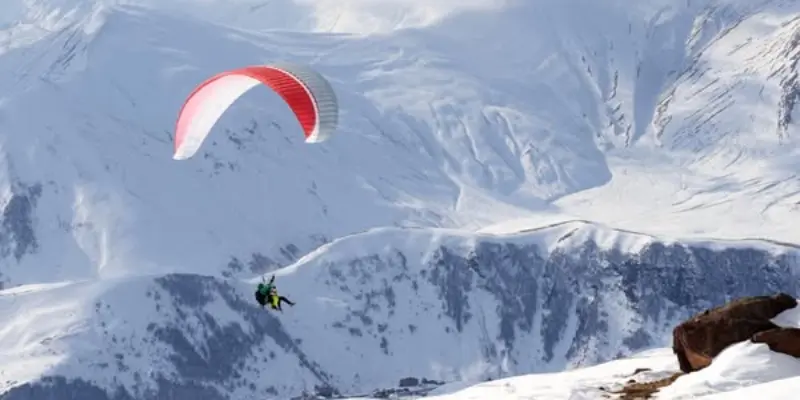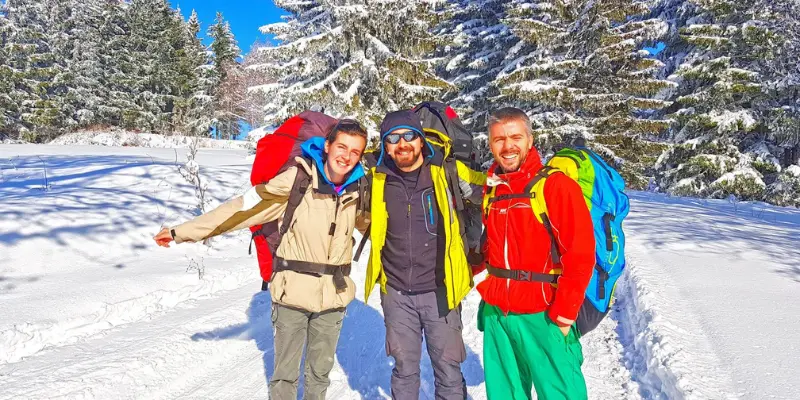Paragliding in Winter: What to Expect & How to Stay Warm
Published: 26 Jul 2025
Ever wondered what it feels like to soar above snowy mountains with cold air brushing your cheeks? Winter paragliding offers that magical thrill with white-covered valleys below and crystal-clear skies above.
But flying in cold weather isn’t the same as flying in summer. It’s colder, windier and needs more preparation. Don’t worry, this guide will walk you through exactly what to expect and how to stay warm so you can enjoy the flight without freezing in mid-air.
Let’s break it down in simple steps so you can fly with confidence, even when it’s chilly!

Is Paragliding Possible in Winter?
Paragliding in winter is absolutely possible but only when the weather allows. The main things pilots look for are calm wind and clear skies. Snow on the ground is not a problem, but wind in the air can make a big difference. If it’s too strong or gusty, the flight might get delayed or even canceled for safety.
Every licensed operator checks real-time weather conditions before each flight. They look at wind speed, temperature, cloud cover and even humidity. If anything seems risky, they postpone flights. So even though you can fly in winter, it all depends on nature giving the green signal.
Best Winter Paragliding Spots in India
India has a few amazing spots where winter paragliding is not only possible, but magical.
Solang Valley (Himachal Pradesh)
This is the most reliable winter paragliding spot. When wind conditions are good, flights run daily. The valley gets covered in snow and you will fly over white meadows, pine trees and snow-capped peaks. Most tourists visit here between December and February.
Bir Billing (Himachal Pradesh)
Bir is famous for world-class flying but it’s more weather-sensitive in winter. Snowfall and wind can limit flights but when it’s clear, it’s breathtaking. January is the quietest month here but you can sometimes catch a flight in late December or early February.
Auli (Uttarakhand)
Paragliding is rare here but possible under the right conditions. Auli is better known for skiing, but on good weather days, you can take short tandem flights. It’s more of a bonus experience than a daily activity.
Example: In Solang Valley, operators often run winter flights between 9 AM and 12 PM when the air is calmest. You might even see snow falling mid-air, making your flight truly one of a kind.
What Makes Winter Paragliding Different?
Paragliding in winter is a special kind of thrill. It’s not just about flying through the air but it’s about flying through a winter wonderland. Everything around you changes with the season: the views, the wind, even the number of people in the sky. Here’s what makes winter paragliding stand out from the rest of the year.
Snow-Covered Landscapes
One of the biggest changes in winter is what you see below. Snow blankets on everything like forests, rooftops, rivers and fields. This gives you a magical view that feels like you’re gliding over a postcard. In places like Solang Valley, the mountain peaks shine bright white, and the whole valley looks frozen in time. It’s incredibly beautiful and peaceful. Winter paragliding is especially popular among people who want that once-in-a-lifetime kind of photo or video.
Colder, Thinner Air
The air in winter is colder and heavier which actually helps with smoother flying. You’ll feel more stable in the air compared to warmer seasons. But the downside? That cold air hits your face hard, especially when you are flying fast. Even if the sun is shining, the wind chill can make it feel freezing. Most flyers say the coldest part isn’t before or after, it’s those 10 to 15 minutes in the air where your face and hands are exposed.
Tip: Always wear a face mask or scarf, warm gloves and a cap or helmet liner under your helmet. Covering your ears is a must!
Fewer Crowds
Winter is usually quieter in the mountains unless it’s the peak holiday season. That means fewer people are booking flights. You will get more personal attention from instructors and won’t have to wait in long lines. The launch sites feel calm and you may even get the entire sky to yourself for a few minutes. It’s a more relaxed and peaceful experience which is perfect for first-timers who are nervous or want a private adventure.
Weather-Dependent Scheduling
Here’s something important: winter weather is tricky. It can change quickly. Some days start out clear and sunny, but fog, snow or wind can roll in by noon. Because of this, operators sometimes pause or cancel flights without warning. But don’t worry, most of them will reschedule your flight at no extra cost. Many winter flyers book morning slots since conditions are usually calmer early in the day.
Bonus: If your flight gets delayed, there’s plenty to do nearby like taking a ropeway ride or visiting places like the Atal Tunnel or local cafes with mountain views.
How Cold Is It Up There?
If you are planning to paraglide in winter, be ready for some serious chill, especially once you are off the ground. It might feel cold on the valley floor but it gets much colder as you rise into the sky. Let’s break it down.
Ground vs. Air Temperature
The higher you go, the colder it gets. On the ground during winter in places like Solang Valley, the temperature usually stays between 5°C to 10°C during the day. But when you’re flying, things change quickly.
As you rise in the air, the temperature can drop by 6°C to 10°C. Plus, the wind chill adds an extra bite. Even on sunny days, the cold breeze hitting your face during the flight can make it feel much colder than expected.
Your body stays still during flight, so you don’t generate much heat. That’s why even short flights can feel freezing if you’re not dressed properly.
Real-Life Example
Let’s say the temperature on the ground is 7°C. Once you’re in the air, it could feel like 0°C or even less because of wind chill and altitude. This is why operators often advise wearing gloves, thermals and windproof jackets, even if it feels okay at base level.
What to Wear for Winter Paragliding

Dressing right can make or break your winter paragliding experience. It’s not just about staying warm, it’s also about staying comfortable and safe during your flight. Let’s go over what to wear from head to toe.
Dress in Warm Layers
Start with thermal innerwear to keep your body heat in. Add a fleece or sweater as a second layer for insulation. Finally, top it off with a windproof jacket to block the cold air while flying. This combo keeps you warm without feeling too bulky.
Cover Hands, Ears & Eyes
Your hands and face will feel the wind the most, so protect them well. Wear touchscreen-friendly gloves, so you can still use your phone if needed. Add a warm cap or balaclava to cover your ears and head. And don’t forget sunglasses as they will help to reduce glare from snow and sunlight.
Footwear Tips
Cold feet can ruin your flight. Wear warm, thick socks and non-slip shoes with good grip.
Example: Hiking boots or ankle-length sneakers work great, especially if there’s snow or wet ground around the takeoff spot.
Essential Winter Gear Checklist
Winter paragliding isn’t just about the thrill, it’s also about staying warm, safe and comfortable. Even short flights can feel tough if you are not properly geared up. Here’s a quick checklist to help you get ready for the cold skies.
- Thermals (top + bottom)
These are your base layers. They trap body heat and keep you warm from the inside. - Windproof outerwear
A good jacket and pants that block wind can make a huge difference once you’re airborne. - Gloves + warm cap
Keep your fingers and ears protected. These parts of your body get cold the fastest. - Sunglasses or snow goggles
These reduce glare and shield your eyes from strong winds or snowflakes. - Sunscreen (UV reflects off snow)
Even in winter, the sun can be harsh. Snow reflects UV rays, so protect your face. - Lip balm (cold air dries lips)
Cold wind dries out lips quickly. Apply balm before flying for comfort.
Tips to Stay Warm Before and After Flight
Paragliding in winter is exciting but the cold can catch you off guard, especially before take-off or after landing. Here’s how to stay warm and enjoy the full experience without shivering through it.
Sip Warm Water or Tea Before the Flight
A hot drink works wonders in cold weather. Warm water or herbal tea keeps your body temperature stable and helps prevent chills. Avoid very sugary drinks, they can lead to a quick energy crash. Carry a small insulated bottle if you are flying early in the morning.
Avoid Heavy Meals Before Flying
It might feel tempting to have a big breakfast but keep it light. Heavy meals can make you feel bloated and queasy, especially when you’re up in the air. Go for easy-to-digest food like toast, fruit or oats about 1–2 hours before your flight.
Do Light Stretching to Warm Up
Don’t sit still while waiting. Simple leg swings, shoulder rolls or a brisk walk gets your blood flowing and helps warm up your muscles. Cold and tight muscles are more prone to cramping. Plus, stretching eases pre-flight nerves.
Stay Active While You Wait
Paragliding often means waiting your turn, especially on busy winter days. Instead of standing still, walk around the take-off area. If you are near a sunlit spot, stay there to absorb natural heat. Movement keeps your body warm and prevents that sudden shiver from creeping in.
Things to Avoid
Winter paragliding is fun but a few common mistakes can make you cold or even unsafe. Here are things you should absolutely avoid before flying.
Don’t Wear Too Many Loose Layers
Layering is smart but too many loose or bulky clothes can flap in the wind. This makes the flight uncomfortable and may interfere with harness straps. Stick to fitted thermal wear and windproof jackets that won’t get in the way.
Avoid Open Shoes or Sandals
Your feet need protection from wind and snow. Open shoes or sandals leave toes exposed, which can lead to numbness or frostbite in extreme cold. Always wear closed, sturdy footwear, preferably with non-slip soles.
Don’t Ignore Sun Protection
Just because it’s cold doesn’t mean the sun isn’t strong. Snow reflects sunlight, increasing UV exposure. Forgetting sunscreen or sunglasses can lead to sunburns or snow glare. Always apply SPF and wear UV-protective eyewear.
What If Flights Get Cancelled?
Paragliding in winter is amazing but the weather doesn’t always cooperate. Flights often get cancelled due to snow, strong winds, or thick fog. Here’s what you should know and do if that happens.
Most Operators Reschedule or Refund
- Most trusted operators offer free rescheduling for the next available flight.
- Full refunds are usually given if weather remains bad for the day.
- Always check the refund/reschedule policy before booking.
- Try to book with operators who have good customer reviews.
- Keep your phone reachable and charged for updates or changes.
Explore Snow Activities While You Wait
- Head to the skiing slopes if you’re in a place like Solang or Auli.
- Take a ropeway ride to enjoy stunning winter views.
- Visit nearby spots like the Atal Tunnel for sightseeing.
- Grab a hot drink at a mountain café to warm up and relax.
- Capture some snowy pictures and make the most of the winter vibe!
Conclusion
Paragliding in winter is a magical experience of quiet skies, snowy views and a real sense of adventure. But the cold can be tough if you’re not ready. That’s why it’s so important to dress right, stay warm and listen to your instructor.
Even if flights get delayed or canceled, don’t worry. You are still in a beautiful place with lots to explore. Enjoy the snow, take in the views and keep your spirit high.
Just remember: stay prepared, stay safe and winter paragliding will be something you will never forget!
FAQs about Aparagliding in Winter
Here are the frequently asked questions about Winter Paragliding:
Yes, winter paragliding is safe only if the weather conditions are right. Operators always check for calm winds and clear skies before flying. Just make sure you dress warmly and follow your instructor’s advice.
Wear thermals, a fleece and a windproof jacket. Also cover your hands, head, and eyes with gloves, a cap, and sunglasses. Warm socks and sturdy shoes are a must.
The air gets much colder than on the ground. If it’s 7°C on the ground, it can feel like 0°C or lower while flying due to wind chill. Dress in layers to stay warm.
No, paragliding is not allowed during snowfall. Snow affects visibility and wind patterns, making it unsafe. Flights usually happen when skies are clear and winds are calm.
Not really. The air may feel cold and sharp, but it’s safe to breathe. You can wear a balaclava or scarf to warm the air before it reaches your lungs.
Yes, flights can get delayed or canceled due to fog, strong winds, or snow. Most operators offer free rescheduling or a full refund if the weather doesn’t cooperate.
Yes, but only if they meet the minimum weight and age limit, usually 6–8 years old. Kids must wear full winter gear and should fly only in calm weather conditions.
Top winter paragliding spots include Solang Valley, Bir Billing and sometimes Auli. Solang Valley is the most consistent, offering winter flights when the wind is stable.
Eat something light at least 1–2 hours before flying. Avoid heavy or spicy meals to prevent nausea, especially since cold air can make you feel dizzy.
Avoid loose clothing, open footwear, and ignoring sun protection. Snow reflects UV rays, so always wear sunglasses and sunscreen even if it’s cold.

- Be Respectful
- Stay Relevant
- Stay Positive
- True Feedback
- Encourage Discussion
- Avoid Spamming
- No Fake News
- Don't Copy-Paste
- No Personal Attacks



- Be Respectful
- Stay Relevant
- Stay Positive
- True Feedback
- Encourage Discussion
- Avoid Spamming
- No Fake News
- Don't Copy-Paste
- No Personal Attacks





